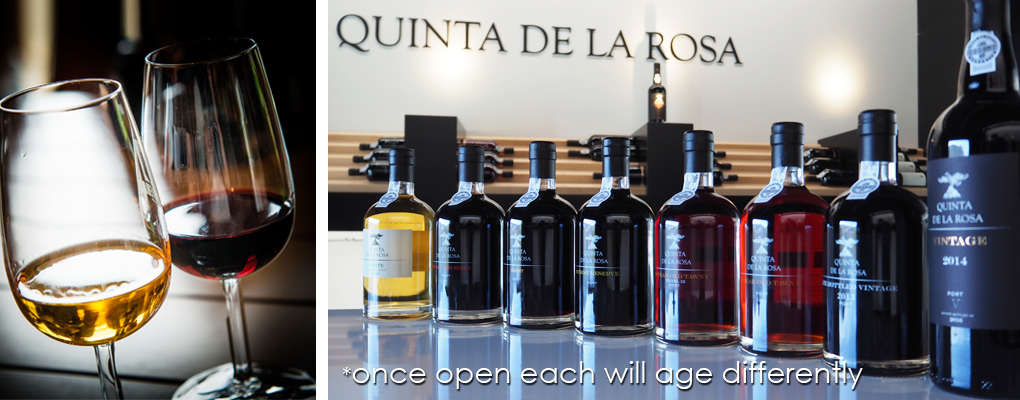How long can you keep an open bottle of Port?
This can vary tremendously as there are so many variables to take into account - but one thing is for certain - it is much shorter than many realise. So the following information is to ensure as best as possible you enjoy your Port at its best and don’t miss out on all the character in such an amazingly complex and dynamic wine.
A rough simple guide: Any Port with a normal full length cork (one where you need a corkscrew to extract) should (when open & stored in a cool place) be consumed within a two-three days to enjoy it at its finest. Any Port with a T-Stopper type cork (can be removed by hand and easily replaced in the bottle) can generally be kept, securely re-corked in a constantly cool place, for a *three-four weeks without significant deterioration of the wine.

Guidelines & Recommendations for Port Wine:
• Vintage Port:
Young Vintage Ports (less than 5 years old) can often last 4 - 5 days once opened. However, older VP’s (more than 15 years old) are not meant to be left open for more than 2 - 3 days. They won’t spoil if left open longer, but they will lose their rich characters and seem a bit more subdued than they did when first opened, especially the aromatics. Really old VP’s (more than 25-30 years old) are at their best when consumed within 24 - 48 hours. Treat Vintage Port like an aged, quality fine red wine.
• LBV Port:
Unfiltered LBV Ports, if stored in a cool place (store approximately 8°C to 10°C) after the bottle has been opened, can provide enjoyment for two sometimes three weeks. For filtered LBV Ports, these typically can last up to 10 to 12 days after being open, without any obvious deterioration of quality.
• Colheita Port:
For younger Colheita Ports (less than 15 years old) they can last up to two - three weeks after being open without any obvious deterioration of quality. Older ones (30 - 40 years of age) are best consumed within 3-4 days.
• Aged Tawny Port - (Oak Aged Styles: 10 - 40 years old):
These can last up to two months after being open without any obvious deterioration of quality, if kept in a cool-dark place. If stored at room temperature (on a back bar), three - four weeks is a good rule of thumb. For Restaurants - 'ideally' have one person keeping a close eye (nose) on the aromas each day after the second-third week.
• Ruby & Tawny Ports:
Ruby and basic Tawny Ports typically *(when stored in cool-dark conditions) will last 4 - 6 weeks after being open, without any obvious deterioration. Though ideally finish a Ruby Port within 1 month - and finish a Tawny Port within 2 months after being opened.
• White Port:
White Port typically *(once open should be stored in the fridge) will last 2 - 3 weeks after being open, without any obvious deterioration. Though ideally finish a White Port within 1 - 2 weeks to enjoy it at its most vibrant - i.e. in a 'White Port-Tonic'.

So why the variations?
• Aged Tawny Ports (10, 20, 30 or 40 years old) are matured in large oak barrels, where oxidation is a key part of the winemaking process - so exposure to oxygen by opening the bottle has less of an affect. A simple Tawny Port usually has a reusable cork and can last for 2 months after opening if kept cool.
• Vintage Ports are aged for less than 2 years before being transferred to bottle (so like a wine, very little exposure or resilience to oxygen) where they can age for another 20 - 30 years (sometimes longer). They are bottled unfiltered and the sediment continues to work inside the bottle. A Vintage Port will only last a couple of days after opening.
• Late Bottled Vintage (LBV) Ports are left in barrels for 4 - 6 years and sometimes filtered before bottling. So their life after opening is somewhere in the middle - plan on 1 - 2 weeks to be safe, but some can last up to a month.
★ Port wines can last longer in an open bottle compared with table wines - because of their higher alcohol content (19% - 22% Alc./vol) acts as a slight preservative *(so does the high level of residual sugar 80 - 120g/L). Refrigerating will extend its useful life to some extent, because refrigeration slows the process of oxidation that causes unpleasant changes in the wine, reducing its aroma and flavour profile.
A sign of Port losing its vitality and character - is the berry fruits and chocolate notes moving more towards nutty notes, which will get more pronounced and tired. A rule of thumb; the older the Port wine, 'once opened' - the shorter the time that it can be stored and enjoyed. Don't miss out on enjoying these dynamic wines at their best.

